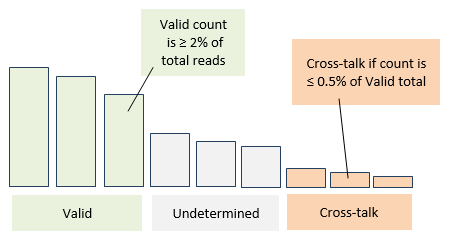See also
Cross-talk
uncross command
UNCROSS paper
Manual annotation of cross-talk
Cross-talk can be
identified by examining an OTU table. If the
lowest-abundance samples in a given OTU have much lower counts than the
high-abundance samples, they are probably due to cross-talk and should be
zero.
You can clearly see cross-talk in this GAIIx example and this MiSeq example.
See the UNCROSS paper for a more formal and complete descrption of the algorithm.
In a mock sample, a high-abundance unexpected OTU, i.e. an OTU which does not match a species in the designed community, is probably a contaminant.
A low-abundance unexpected mock count is probably cross-talk if it is also present in another sample. An alternative explanation is a low-abundance contaminant in the mock sample which is a valid OTU in the environmental samples by coincidence; this is a much less likely explanation. Another possible explanation is contamination which affects multiple samples, e.g. flow-cell residue from previous runs; this is also considered to be less likely than cross-talk.
Under these assumptions, mock samples enable a more sensitive test for the
presence of cross-talk. For example, if an unexpected mock OTU has two reads
and some other sample has ten reads then the most likely explanation is
cross-talk. The anomalously large cross-talk rate of 2/12 = 17% of the reads
can be explained by fluctuations due to sampling effects when there are
small total numbers of reads, which can result in high outlier values for
some OTUs. In environmental samples, OTUs cannot be considered as expected
or unexpected so abundances of two and ten in an OTU with twelve total reads
is not a reliable indicator of cross-talk.
Automated
annotation of cross-talk
The UNCROSS algorithm uses simple
heuristics to automate the manual procedure described above for annotating
cross-talk. UNCROSS-Ref predicts cross-talk in mock samples where OTUs are
annotated as matching (or not matching) the designed mock community.
UNCROSS-Denovo predicts cross-talk in all samples considering read counts
alone. These approaches are complementary. UNCROSS-Ref can identify
unexpected OTUs by comparison with the database and is thus more sensitive
to cross-talk in OTUs with low overall abundance, but cannot detect or
correct cross-talk in environmental samples. UNCROSS-Denovo is less
sensitive to cross-talk in OTUs with low overall read counts, but can detect
cross-talk in environmental samples and can thus be used to detect and
correct cross-talk in practice.
UNCROSS is not a robust solution
for cross-talk
The mechanism(s) causing cross-talk are not well
understood. Many different indexing schemes are used. Cross-talk rates in
your data may be quite different from the datasets on which UNCROSS was
designed and tested, in which case the accuracy of UNCROSS on your data may
be lower. Also, cross-talk may be hard or impossible to detect when the
number of multiplexed samples is large, say around 100 or more. It is much
better to use multiplexing strategies that are designed to reduce
cross-talk. UNCROSS is best understood as a simplisitc hack that is the best
we can do with exisitng data.

Schematic illustration of the UNCROSS-Denovo algorithm. The OTU table entries
for a given OTU are shown sorted by decreasing count (number of reads). If a
count is at least 2% then it is classified as valid. If a count is ≤ 0.5% of
the total over valid counts, it is predicted to be due to cross-talk.
Intermediate values are classified as undetermined.